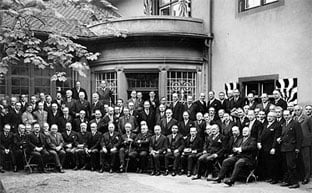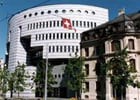Big bank profits are bogus! Massive public deception!
by Martin D. Weiss, Ph.D. 04-20-09

A big bank CEO on a mission to deceive the public doesn’t have to tell outright lies. He can con people just as easily by using “perfectly legal” tricks, shams, and accounting ruses.
First, I’ll give you the big-picture facts. Then, I’ll show you how big U.S. banks are painting lipstick on some of the fattest pigs ever raised.
Six of America’s Largest Banks at Risk of Failure
As we have written here so often … as we documented in our recent white paper … as we showed in our presentation to the National Press Club … and as we explained again with new data in our follow-up press conference, the nation’s banking troubles are many times more severe than the authorities are admitting.
First, look at the megabanks: The authorities SAY that all of the 14 largest banks have earned a “passing” grade in their just-completed “stress tests.” But just six months ago, the authorities swore that, without a massive injection of taxpayer funds, those same banks would suffer a fatal meltdown.
Was the bad-debt disease magically cured? Did the economy miraculously turn around? Not quite. In fact, we have overwhelming evidence that the condition of the nation’s banks has deteriorated massively since then.
How can our trusted authorities be so blatantly deceptive and still keep their jobs? Perhaps you should ask Fed Chairman Ben Bernanke. Not long ago, for example, he declared that the total losses from the debt crisis would not exceed $100 billion, while conveying the hope that most of those losses could be soon written off. Also around that time, the International Monetary Fund (IMF) estimated the losses would be $1 trillion, with only a small percentage written off.
The IMF’s latest estimate: $4 trillion in losses, with only one-third of those written off so far. Bernanke’s error factor: He was 4,000 percent off the mark, in a world where 50 percent errors can be lethal.
Meanwhile, based on fourth quarter Fed data, we find that, among the nation’s megabanks, six are at risk of failure in our opinion (seven if you count Wachovia and Wells Fargo as separate institutions).JPMorgan Chase is the nation’s largest, with $1.7 trillion in assets in its primary banking unit. It’s massively exposed to defaults by its trading partners in derivatives — to the tune of 382 percent (almost four times) its risk-based capital. Plus, since it holds HALF of ALL the derivatives in the U.S. banking industry, JPMorgan is at ground zero in the debt crisis.

Citibank is the nation’s third largest, with assets of $1.2 trillion in its main banking unit. Its total credit exposure to derivatives is a bit lower than Morgan’s, at 278 percent, but still extremely high. Plus, it has other troubles, especially the surging default rates in its sprawling global portfolio of credit cards and other consumer loans. (More on these in a moment.)
Wells Fargo and Wachovia now make up the nation’s fourth largest bank with combined assets of $1.17 trillion. But in the fourth quarter, they still reported separately, which is illuminating: Even without Wachovia’s troubled assets, TheStreet.com Ratings has downgraded Wells Fargo to a D+. Wachovia, meanwhile, got a D. This tells you that Wells Fargo wasn’t exactly the best merger partner, unless you believe in some bizarre math wherein adding two negatives somehow gives you a positive result.
SunTrust, with $185 billion in assets, is getting hit hard by the collapse in the commercial real estate. Its Financial Strength Rating is D+.
HSBC Bank USA has massive credit exposure to derivatives that’s even greater than Morgan’s: 550 percent of risk-based capital. We’re not looking at its larger foreign operations. But the U.S. numbers are ugly enough, meriting a rating of D+.
Goldman Sachs, which reported for the first time as a commercial bank in the fourth quarter, seems to be taking the biggest risks of all in derivatives. Its total credit exposure is 1,056 percent of capital. Bottom line: It debuts as a bank with a rating of D, on par with Wachovia.
Regional banks: Banking regulators have been largely mute regarding major regional banks. But several are also at risk of failure, including Compass Bank (Alabama), Fifth Third (Michigan), Huntington (Ohio), and E*Trade Bank (Virginia). Primary reason: Massive losses in commercial real estate loans.
Smaller banks: On its “Problem List,” the FDIC reports only 252 institutions with assets of $159 billion. In contrast, our list of at-risk institutions includes 1,816 banks and thrifts with $4.67 trillion in assets. That’s seven times the number of institutions and 29 times more assets at risk than the FDIC admits.
What Explains the Huge Gap BetweenOfficial Declarations and Our Analysis?
We all use essentially the same data. And conceptually, the analytical approach is also similar.
The primary difference is that the regulators have an agenda: Instead of protecting the people from bank failures, they’re trying harder than ever to protect failed banks from the people. Specifically …
They have forever hidden the names of the banks on the FDIC’s “Problem List,” making it almost impossible for average consumers to get prior warnings of troubles.
They have never disclosed their own official ratings of the banks — the CAMELS ratings — making it difficult for the public to find safe institutions they can trust.
They have religiously underestimated — or understated — the depth and breadth of the debt crisis.
And as I explained a moment ago, they have rigged their recent stress tests to give passing grades to all of the nation’s 14 largest banks, sending the false signal that even the most dangerous among them are somehow “safe.”
Legal Cover-Ups, Flim-Flam and ShamIn the Big Bank’s “Glowing” First-Quarter Earnings Reports
Wall Street is aglow with the latest “better-than-expected” earnings reports by major banks. But take one look below the surface, and you’ll see three of the most egregious accounting gimmicks in recent history.
Gimmick #1. Toxic asset cover-up. In their infinite wisdom, global banking regulators have now agreed to let banks cover up their toxic assets by booking them at fluffy-high values, bearing little resemblance to actual market prices. Like magic, the bad assets are suddenly worth more, as hundreds of billions in losses are defined away.
Gimmick #2. Reserve flim-flam. Every quarter, banks are required to estimate their losses and decide how much to set aside in loss reserves. If they deliberately guess too much in one quarter and too little in the next, they can shove all their bad earnings into earlier P&Ls and make future P&Ls look rosy by comparison.
Gimmick #3. The great debt sham. Consider this scenario: A financially distressed real estate developer owes the bank $4 million. His revenues have plunged. He’s lost a fortune in his properties. And he’s on the brink of bankruptcy.
Therefore, in the secondary market, traders recognize that loans like his are worth, say, only half their face value, or about $2 million. So far, a very common situation, right?
But now imagine this: He walks into the bank one morning and claims that he really owes only $2 million. Why? Because, in theory, he says, he could buy back his own loan for that price, thereby reducing his debt in half.
In practice, of course, that’s a pipedream. If he actually had the cash to buy back his own loans on the market, then he wouldn’t be financially distressed in the first place. And if he weren’t financially distressed, his loans wouldn’t be selling on the market for half price.
The reality is that he can’t buy back his own debt and never will. And even if he could someday, he will still be on the hook for the full $4 million unless and until he files for bankruptcy and the bankruptcy judge decides otherwise.
That’s why the government would never let real estate developers — or hardly anyone else, for that matter — mark down the debts on their books and still stay in business. But guess what? The government lets banks do precisely that!
It’s the ultimate double standard: The banks get away with inflating their toxic assets. But at the same time, they’re allowed to mark to market their own debts, which happen to be trading at huge discounts on the open market precisely because of their toxic assets.
Accountants call it a “credit value adjustment.” I call it cheating.
Finding all of this hard to believe? Then consider …
How Citigroup Mobilized ALL THREE of TheseGimmicks to Create One of the Greatest AccountingShams of All Time in Its First-Quarter Earnings Report
I’m outraged. But I’m glad to see that someone besides us is speaking out:
Meredith Whitney, one of the few no-nonsense analysts in the industry, says that the banks’ latest reports are, in essence, “a great whitewash.”
Jack T. Ciesielski, publisher of an accounting advisory service, calls it “junk income.”
And Saturday’s New York Times, picking up from their research, lays out precisely how Citigroup has transformed a massive loss into what appears to be a fat profit …
First, Citigroup deployed the Toxic Asset Cover-Up. By inflating the value of the bad assets on its books, it was able to beef up its after-tax profits by $413 million.
Second, Citigroup used the Reserve Flim-Flam gimmick: By (a) shoving most of its bad-debt losses into last year’s fourth quarter and (b) greatly understating its likely losses in the first quarter, the bank legally rigged its books to look like it had made major improvements. Even assuming no further deterioration in its loan portfolio, I estimate this gimmick alone bloated profits by at least another $1 billion.
Third, Citigroup went all out with the Great Debt Sham, marking down its own debt and creating an additional $2.7 billion in purely bogus profits from this maneuver alone.
So here’s Citigroup’s true math for the first quarter:
So-called “profit”
$1.6 billion
Gimmick #1
$0.4 billion
Gimmick #2
$1.0 billion
Gimmick #3
$2.7 billion
Total gimmicks
$4.1 billion
Actual result:
$2.5 billion LOSS!
And all this despite the fact that Citigroup’s loan portfolios actually deteriorated further in the first quarter. Based on its
Q1 2009 Quarterly Financial Data Supplement, we find that:
Net credit losses in Citi’s global credit card business surged from $1.67 billion at year-end 2008 to $1.94 billion by March 31. And compared to March 2008, they surged by a whopping 56 percent! (Page 9 of its data supplement.)
Foretelling future credit card losses, the delinquency rate (90+ days past due) on those credit cards jumped from 2.62 percent at year-end to 3.16 percent on March 31 (page 10).
Credit losses on consumer banking operations jumped from $3.442 billion on December 31 to $3.786 billion on March 31. And compared to the year-earlier period, they surged 66 percent (page 12).
By almost every measure, Citigroup’s first-quarter numbers are worse than they were just three months earlier and far worse than they were 12 months before.
My forecast: Citigroup’s effort last week to twist this into an “improvement” will go down in history as one of the greatest banking deceptions of all time.
But Citigroup is not the only one. Nearly all other major banks are suffering similar surges in their credit losses and delinquency rates. Nearly all are using at least one of the same gimmicks to bloat their first-quarter profits. And every single one is destined to see massive new losses, driving their shares to new lows and the banking system as a whole into a far more severe crisis.
Bottom line: Rather than the private-public partnership the government has called for to address the nation’s banking woes, we see little more than private-public collusion to hide the truth from the public, paper over the problems and, ultimately, sink the banks into an even deeper hole.
My Recommendations
In my book, The Ultimate Depression Survival Guide, I give you very detailed, step-by-step instructions on what to do immediately. Here’s a quick summary:
Step 1. Get away from risky stocks. Use the recent stock market rally as a selling opportunity — your second chance to get out of danger before it’s too late.
Step 2. Get out of sinking real estate. If there’s a temporary improvement in the market, grab it to sell the properties you’ve been wanting to sell all along.
Step 3. Raise as much cash as you possibly can — not only by selling stocks and real estate, but also by cutting expenses and selling other things you own.
Step 4. Make sure you keep your cash in one of the safe banks on the list we provide on the book’s resource page. Or better yet, follow my instructions on how to buy Treasury bills. They’re safer than any bank, with no limit on the Treasury’s direct guarantee.
Step 5. For assets you cannot sell, buy protection using exchange-traded funds that are designed to go UP when stocks fall. The more the market goes down, the more you make; and those profits can offset any losses you suffer in the stocks or real estate that you cannot sell.
Step 6. Later, get ready for the big bottom in nearly all markets. That’s when you should be able to lock in relatively safe interest rates of 10 percent or more for years to come … buy shares in our country’s best companies for pennies on the dollar … buy a dream home in a great location that’s practically being given away.
The book is now a Wall Street Journal bestseller. You can effectively get as many copies as you want for free, because you earn a $29.95 Weiss Research credit for each one you buy for yourself or others — either for a new service or a renewal. And I am donating 100 percent of my royalties to a national charity — the Campaign to End Child Homelessness.
Click here to order.
Good luck and God bless!
Martin
These icons link to social bookmarking sites where readers can share and discover new web pages.
















 ISLAMABAD: The leading newspaper of Sri Lanka, Daily Mirror, in its editorial has criticised the role the Indian intelligence agency (RAW) is playing in the regional countries to destabilise them. The editorial has specially referred to Pakistan.
ISLAMABAD: The leading newspaper of Sri Lanka, Daily Mirror, in its editorial has criticised the role the Indian intelligence agency (RAW) is playing in the regional countries to destabilise them. The editorial has specially referred to Pakistan.



